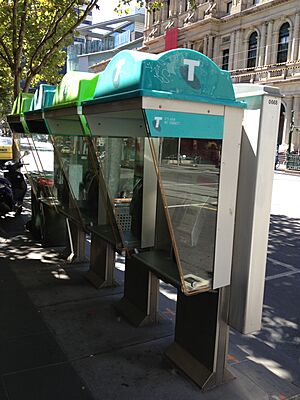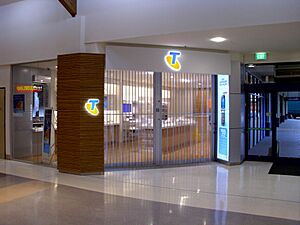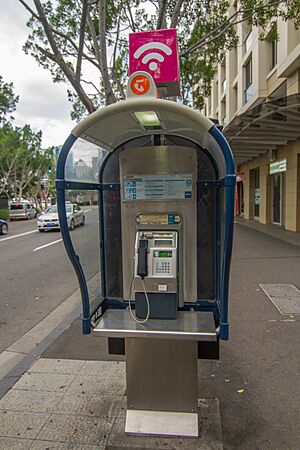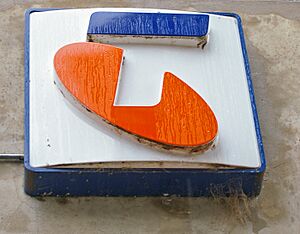Telstra facts for kids
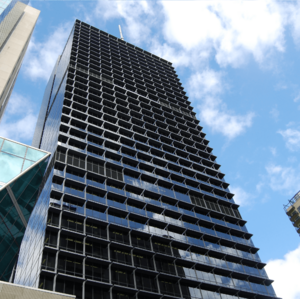
Telstra Corporate Centre in Melbourne
|
|||
|
Trade name
|
Telstra | ||
|---|---|---|---|
|
Formerly
|
List
Australian Telecommunications Commission (1979–1989)
Australian Telecommunications Corporation (1989–1991) Australian and Overseas Telecommunications Corporation (1991–1993) Telstra Corporation Limited (1993–2023) |
||
| Public | |||
| Traded as |
|
||
| Industry | Telecommunications | ||
| Founded | 1 July 1975 | ||
| Headquarters | Telstra Corporate Centre Melbourne, Australia |
||
|
Area served
|
Australia Worldwide (selected products) |
||
|
Key people
|
Vicki Brady (CEO) Michael Ackland (CFO) John Mullen (Chairman) |
||
| Products | Fixed line and mobile telephony, Internet, data services, network services, and pay TV | ||
| Brands | Belong | ||
| Revenue | |||
|
Operating income
|
|||
| Total assets | |||
| Total equity | |||
|
Number of employees
|
c. 31,000 (2023) | ||
| Subsidiaries | 150 subsidiaries Foxtel (35%) Amplitel (51%) |
||
|
|||
| Footnotes / references Financials as of 30 June 2023[update] |
|||
Telstra Group Limited is a big Australian company that helps people communicate. It builds and runs phone and internet networks, and sells related products and services. Telstra is the largest telecommunications company in Australia.
Telstra has a long history, starting way back in 1901. It was once a government-owned business, but by 2006, it became a fully private company.
Contents
- Telstra's Journey: From Government to Private Company
- David Thodey's Time as CEO (2010–2015)
- Andrew Penn's Time as CEO (2015–2022)
- Vicki Brady's Time as CEO (2022–present)
- Telstra's Products and Services
- Telstra's Mobile Networks
- Telstra's Place in the Market
- Telstra's Leaders (CEOs)
- Telstra's International Business
- Selected Events
- See also
Telstra's Journey: From Government to Private Company
Australia's phone and internet services were first managed by the Postmaster-General's Department (PMG) in 1901. This happened when Australia became a federation, joining all its states together. Before 1901, each state handled its own communication services.
On 1 July 1975, the PMG was split into two new groups. One group, Australia Post, took care of mail. The other, called the Australian Telecommunications Commission (ATC), or Telecom Australia, managed phone services within Australia.
In 1993, Telecom Australia merged with another government body, the Overseas Telecommunications Commission (OTC). This new company was first called the Australian and Overseas Telecommunications Corporation (AOTC). Soon after, it was renamed Telstra Corporation Limited. The name "Telstra" comes from "Tel" in Telecom and "stra" in Australia. The company used the "Telstra" name for international business and "Telecom Australia" for local business until 1995, when it became "Telstra" everywhere.
Telstra has faced competition from other companies like Optus since the early 1990s. Telstra used to own the fixed-line phone network. However, with the upgrade to the National Broadband Network (NBN), the Australian Government now owns these lines. Telstra still plays a big role in the NBN by providing resources. Telstra also offers pay TV and owns 35% of the Australian media company Foxtel.
The Overseas Telecommunications Commission (OTC)

The Overseas Telecommunications Commission (OTC) was created in 1946. Its job was to handle all international phone and internet services for Australia. This meant managing calls and data going into, through, and out of the country.
In 1992, the OTC joined with Telecom Australia. This created the Australian and Overseas Telecommunications Corporation (AOTC). This new company later became Telstra Corporation Limited, known as Telstra.
How Telstra Became a Private Company
Starting in 1997, the Australian Government began selling its shares in Telstra. This process, called privatisation, finished in 2011.
- In 1997, the government sold one-third of its shares for about A$14 billion. Telstra was then listed on the Australian Stock Exchange.
- By 1998, more shares were sold, leaving the government with 51% ownership.
- In 2006, the government sold even more shares, reducing its ownership to 17%. The remaining shares were put into Australia's Future Fund. This fund helps pay for future government employee pensions.
- By 2011, the Future Fund sold almost all its Telstra shares. This meant Telstra was now fully owned by many different shareholders, not the government.
Today, Telstra has over a million shareholders, making it one of the most widely owned companies on the Australian Stock Exchange.
Telstra and the National Broadband Network (NBN)
In 2008, the Australian government asked companies to bid on building a new National Broadband Network (NBN). Telstra proposed a $5 billion network. However, Telstra's plan didn't meet the government's requirements for how much of Australia it would cover. Because of this, Telstra was not chosen to build the NBN.
Later, in 2011, Telstra and NBN Co Limited (the company building the NBN) signed a big agreement. Telstra agreed to disconnect its internet customers from its old copper and cable networks in areas where the NBN was being installed. Telstra also agreed to let NBN Co use its infrastructure, like ducts and exchange spaces. This deal was worth about A$9 billion to Telstra.
In 2014, a new agreement was made. Telstra would transfer ownership of its copper and cable networks to NBN Co. This allows NBN Co to use these networks for its NBN rollout.
David Thodey's Time as CEO (2010–2015)
Under CEO David Thodey, Telstra worked to improve its sales and customer service. In 2014, the Australian Financial Review newspaper named Telstra the "most respected company."
Improving Customer Service
Telstra aimed to make customer service a key part of everything it did. In 2011, Telstra started offering customer service through social media, available 24/7. By 2012, they had 140,000 live chats per month. They also increased their live chat team to 600 people and their social media team to 30.
The table below shows how many complaints were made to the Telecommunications Industry Ombudsman (TIO) about Telstra compared to all complaints:
| Year | Total complaints | Complaints about Telstra | Percentage of all complaints |
|---|---|---|---|
| 2010 | 167,772 | 78,611 | 47% |
| 2011 | 197,682 | 78,949 | 40% |
| 2012 | 193,702 | 69,991 | 36% |
| 2013 | 158,652 | 57,298 | 36% |
| 2014 | 138,946 | 58,009 | 42% |
| 2015 | 124,417 | 55,529 | 45% |
Telstra's Digital Services
In 2011, Telstra created "Telstra Digital" to improve how customers used online services. They relaunched their website and started "CrowdSupport," an online forum where customers could help each other. By 2017, CrowdSupport had 463,000 posts.
Telstra Digital also launched new apps for smartphones and Facebook, allowing customers to manage their accounts. By 2013, these apps had 2.5 million downloads. The CEO, David Thodey, noted that the new online strategy was working, leading to fewer calls to their service centers. Telstra estimated that its digital program would save $100 million in 2013 by reducing printing costs and call center staff.
In 2014, Telstra announced a "Digital First" program to have 65% to 70% of its customer interactions happen online.
| Metric | 2011 | 2013 | 2015 | June 2015 | June 2016 | August 2016 |
|---|---|---|---|---|---|---|
| Digital service transactions share | 26% | 44% | 50% | 52% | 56% | |
| Digital customer contacts per month | 10m | 23m | 33m (monthly average) | Not disclosed | 48m (grossed up from weekly) | |
| MyAccount users | 0.5m | 2.6m | Not disclosed | Not disclosed | 2.5m | |
| Regular 24x7 mobile app users | 0.0m | Not disclosed | 2.1m | 2.3m | 2.6m | 2.9m |
| Digital payments transaction share | Not disclosed | Not disclosed | 75% | |||
| Digital prepaid recharge share | Not disclosed | Not disclosed | 50% | |||
| Monthly live chat sessions | Not disclosed | Not disclosed | Not disclosed | 350,000 |
Telstra Stores and New Look
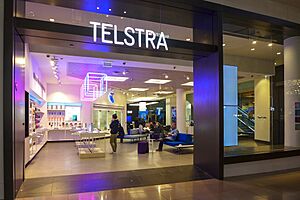
Telstra has many retail stores across Australia. Some are owned by Telstra, and others are run by partner companies. By May 2016, there were 360 Telstra stores. Some new "Discovery" stores were designed to offer unique experiences with new displays and free baristas.
In 2011, Telstra opened the world's first Android store, called "Androidland", in Melbourne.
In 2011, Telstra also launched a new brand identity with a new color scheme and the slogan "It's how we connect." By 2016, Telstra became Australia's most valuable brand.
Sponsorships and Partnerships
Telstra supports many awards in Australia, like the Australian Business of the Year award. They also sponsor the National Aboriginal & Torres Strait Islander Art Award (NATSIAA), which is now known as the Telstra Award.
Telstra has sponsored sports events, including the V8 Supercars car racing championship and the National Rugby League Premiership. They also sponsor Swimming Australia.
In 2021, Telstra partnered with the eVTOL racing series Airspeeder. This deal helps provide data communication for their flying vehicles.
When the Australian government first sold Telstra shares in 1997, they were priced at $3.30 to $3.40 per share. In 1999, shares were sold for $7.40 to $7.80. In 2006, they were sold for $3.60.
After becoming a private company, Telstra's shares reached a low of just over $2.50 in late 2010. However, they rose to $5 by December 2013 and $6 by December 2014. In May 2019, shares closed at $3.56.
During the global pandemic in 2020, Telstra was one of the few companies on the Australian Securities Exchange (ASX) that saw its share price increase.
Telstra Health
In 2013, Telstra started a new business unit called Telstra Health. This unit focuses on health technology. Telstra Health has acquired several companies to expand its services, including HealthConnex, Verdi, and Dr Foster Intelligence.
Andrew Penn's Time as CEO (2015–2022)
Andy Penn became Telstra's CEO in 2015. His time was challenging due to the big changes from the NBN rollout. Penn focused on growing Telstra's main business and reducing its international presence.
In 2016, Telstra had some network outages, and the company apologized for them. Penn announced a $3 billion investment to improve Telstra's networks.
In 2017, Telstra's revenue and profit dropped because of the NBN rollout. As a result, Telstra reduced its dividend (money paid to shareholders), which caused its share price to fall.
T22 Strategy
In 2018, Telstra announced its "Telstra2022" (T22) strategy. This plan aimed to help the company grow again after the NBN changes. The strategy had four main goals:
- Improve customer experiences.
- Make products and operations simpler.
- Keep Telstra's networks superior and lead in 5G technology.
- Improve employee engagement.
- Reduce costs.
- Get a good return on investments after the NBN.
As part of T22, Telstra announced it would reduce about 8,000 jobs, while also creating 1,500 new roles.
InfraCo
On 1 July 2018, Telstra created Telstra InfraCo. This new part of the company owns Telstra's infrastructure, like data centers, fiber optic cables, and exchanges. InfraCo's assets are worth about $11 billion. In 2021, InfraCo opened its "dark fiber" network in six Australian capital cities. This network offers high-speed connections for other network operators.
Retail Store Strategy
In 2021, Telstra announced plans to take full ownership of all its retail stores. This process took about 12 to 18 months. Telstra also brought its call centers back to Australia as part of the T22 plan.
The T22 strategy was very successful. It led to much better customer service, happier employees, and a return to profitable growth. Telstra's share price increased by more than 50% from 2018 to 2022.
Vicki Brady's Time as CEO (2022–present)
On 1 September 2022, Vicki Brady became Telstra's new chief executive officer.
Telstra's Products and Services
Phone Services: Fixed-line and Mobile
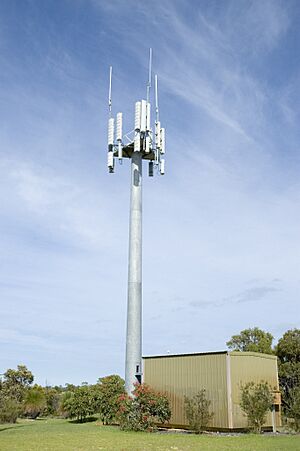
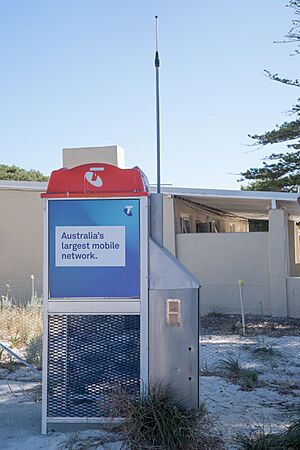
Telstra is Australia's largest provider of fixed-line phone services for homes and businesses. They also own and maintain most of Australia's public payphones. In 2006, Telstra started removing many payphones because fewer people were using them due to mobile phones.
Telstra Mobile is Australia's largest mobile phone service provider. It has the most customers and the widest coverage. Telstra operates Australia's largest GSM and 3G networks. As of 2007, Telstra had about 9.3 million mobile customers.
Telstra was the first company to offer mobile phone services in Australia in 1981. In 1987, they launched the first system for portable hand-held phones.
Internet Services
Telstra provides internet services for both individuals and businesses. They use different ways to deliver internet, including ADSL, Cable, Satellite, and Wireless Internet.
Telstra's internet service was originally called BigPond. In 2013, it was brought under the main Telstra brand. In 2007, BigPond had over two million broadband customers.
Cable Internet
Telstra is Australia's largest provider of Cable Internet access. This service covers parts of major Australian cities. Speeds can go up to 100 Mbit/s (megabits per second) for downloads. Telstra used to own and operate the largest cable internet network in Australia. This network has since been acquired by NBN Co.
ADSL Internet
Telstra offers ADSL and ADSL2+ services. These services provide internet speeds from 256 kbit/s (kilobits per second) up to 20 Mbit/s. In 2006, Telstra increased wholesale ADSL speeds. In 2008, Telstra activated high-speed ADSL2+ broadband in many more telephone exchanges across Australia.
Mobile Broadband
Telstra provides the largest wireless network coverage in Australia, reaching 99% of the population. Download speeds on the 3G network range from 256 kbit/s to 21 Mbit/s. On the 4G network, speeds can be up to 100 Mbit/s. Telstra's mobile network now includes 4GX and 5G in major cities and some regional areas.
Satellite Internet
Telstra offers satellite internet mainly for customers in regional areas who are too far from an exchange to get ADSL or cable. Satellite speeds range from 256 kbit/s to 800 kbit/s for downloads.
Dial-up Internet
Telstra offered dial-up internet from 1995 until early 2015. They no longer sell this service.
Belong: Low-Cost Mobile and Internet
In 2013, Telstra launched "Belong," a brand that offers lower-cost mobile and internet services. By 2020, Belong had over 600,000 customers. Belong is Australia's first carbon-neutral telecommunications provider. This means they work to balance out the carbon emissions they produce.
Subscription Television
Telstra's cable network is used by Foxtel, an Australian subscription television provider. Telstra owns 35% of Foxtel in a joint venture with News Corp Australia. Telstra also sells Foxtel services to its customers.
Entertainment and Content
Telstra used to offer various entertainment services:
BigPond Music
Telstra partnered with MOG to offer an online music service called BigPond Music in Australia. This service launched in 2012 but ended in 2014. It was replaced with bonus offers related to Apple Music.
BigPond Games and GameArena
GameArena was a website under the BigPond brand that focused on video gaming. It offered news, downloads, and game servers. GameArena provided advantages to Telstra customers, such as faster downloads and unmetered usage (meaning it didn't count towards their data limits). GameArena closed in 2014.
The Pond in Second Life
Telstra BigPond had virtual islands in the online game Second Life for about three years, closing them in 2009.
Facebook "Blurtl"
In 2011, Telstra launched "Blurtl," a Facebook app that let users leave audio messages on their Facebook walls.
Free Payphones
In 2021, Telstra made its payphones free to use. This was done for several reasons:
- They can be used in emergencies, like when mobile phones don't work due to fires, floods, storms, or flat batteries.
- The cost of collecting money from payphones was becoming more than the money they earned.
- It benefits people who don't have a mobile phone.
Telstra's Mobile Networks
Telstra uses different frequencies and technologies for its mobile network.
| Frequency | 3GPP band | Protocol | Class | Notes |
|---|---|---|---|---|
| 850 MHz | 5/n5/26/n26 | UMTS/HSPA/HSPA+/DC-HSPA+/LTE/NR | 3G/4G/5G | This frequency was first used for the 1G AMPS network in 1987. After that network closed in 2000, the frequency was used for the Telstra Next G 3G network, which covers 99% of Australia. The 3G 850 MHz network is planned to close in June 2024 so the frequency can be used for 5G. |
| 700 MHz | 28 | LTE/LTE-A | 4G | This frequency became available after Australia switched from analog to digital TV. It was launched for Telstra's "4GX" service in 2015. |
| 1800 MHz | 3 | LTE/LTE-A | 4G | This was first used for the 2G GSM network. Now it's used for 4G LTE in major cities and regional centers. |
| 2100 MHz | 1 | LTE/LTE-A | 4G | Originally used for 3G, this frequency is now used to add more capacity in busy 4G areas. |
| 2600 MHz | 7/n7 | LTE/LTE-A/NR | 4G/5G | This frequency adds more capacity to the 700 MHz and 1800 MHz networks in busy areas. It was activated in 2014 and will be used for 5G. |
| 3500 MHz | n78 | NR | 5G | This frequency is used for 5G, with different channel sizes depending on the location. |
| 26000 MHz | n258 | NR | 5G | This frequency was bought in 2021 and will be used for very high-speed 5G technology called Millimetre Wave (mmWave). |
In 2011, Telstra started rolling out its 4G 1800 MHz LTE network, promising download speeds of up to 40 Mbit/s. By 2012, the main 4G rollout was complete. In 2013, Telstra showed off the world's first LTE-Advanced Carrier Aggregation network. In 2017, Telstra launched the world's first Gigabit LTE-Advanced mobile network.
In 2019, Telstra closed the 2100 MHz part of its 3G network. In 2020, Telstra launched Australia's first 5G network using 3500 MHz spectrum.
Next G Network
In 2005, Telstra announced a plan to build a new 3G network to replace its older CDMA mobile network. This new network, called Next G, was built between 2005 and 2006 and launched in October 2006. By 2007, Next G was the largest mobile network in Australia, with wider coverage than other 3G networks.
In 2008, the Next G Network was considered the fastest mobile network in the world, with theoretical speeds up to 21 Mbit/s. By 2010, Telstra increased the speed to 42 Mbit/s, making it the fastest again.
Network Design
The Next G network was built to replace Telstra's older CDMA network, which closed in 2008. Telstra chose to use the 850 MHz frequency for Next G. This frequency needs fewer base stations to provide coverage, which helps save money. The network was built by Ericsson.
4GX Network
On 1 January 2015, Telstra launched "4GX." This is a part of its mobile network that uses the 700 MHz frequency. It offers speeds of up to 75 Mbit/s with compatible devices. 4GX has expanded to use multiple frequencies (700, 1800, 2100, and 2600 MHz) to offer speeds up to two gigabits in some areas.
Telstra's Place in the Market
Since Australia's telecommunications industry became more open to competition in the early 1990s, Telstra has remained the largest provider. This is despite competition from rivals like Optus and TPG Telecom.
In 2011, Telstra increased its market share by offering discounts on its mobile phone products. By 2020, Telstra's revenue was $26.2 billion, showing its strong position in the market.
Telstra's Leaders (CEOs)
| Year appointed | CEO |
|---|---|
| 1986 | Mel Ward |
| 1993 | W. Frank Blount |
| 1999 | Ziggy Switkowski |
| 2005 | Solomon Trujillo |
| 2009 | David Thodey |
| 2015 | Andrew Penn |
| 2022 | Vicki Brady |
Telstra's International Business
Telstra has more than 200 smaller businesses that it owns. Here are some of its major international holdings:
| Year | Name | Type of ownership | Comments |
|---|---|---|---|
| 1992 | 100% | Telstra has been working in Europe since 1992, providing data, voice, and network services to over 7,000 customers. | |
| 2003 | 50% venture, with PCCW | This partnership was created for international communication. | |
| 2008 | 100% | This is a communication cable that connects Sydney and Hawaii. It started working in 2008. | |
| 2011 | Joint venture with Microland | This partnership allows Telstra to offer long-distance and internet services in several Indian cities. | |
| 2011 | 100% | This license allows Telstra to build and operate voice and data networks in Singapore. | |
| 2011 | 100% | Telstra Japan operates large-scale telecommunications networks and services in Japan. | |
| 2015 | 49% | This company provides network services to businesses in Indonesia. | |
| 2015 | 100% | This company was bought to become part of Telstra Health. |
Selected Events
Privacy Investigation
In 2011, an investigation looked into a mistake where Telstra accidentally sent personal information of about 60,300 customers to other customers. The investigation found that it was a one-time human error. It was not because Telstra failed to have good security measures in place. Telstra acted quickly to fix the problem, tell customers, and review its data security.
See also
 In Spanish: Telstra para niños
In Spanish: Telstra para niños
- Telstra Business Awards
- Internet television in Australia
- Subscription television in Australia




